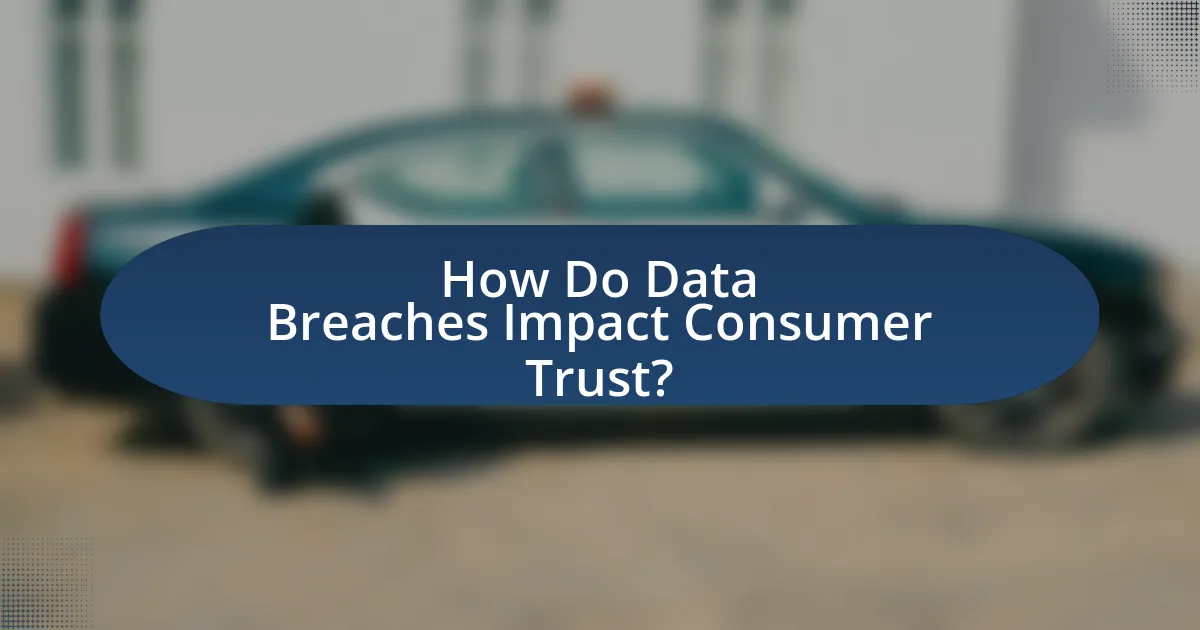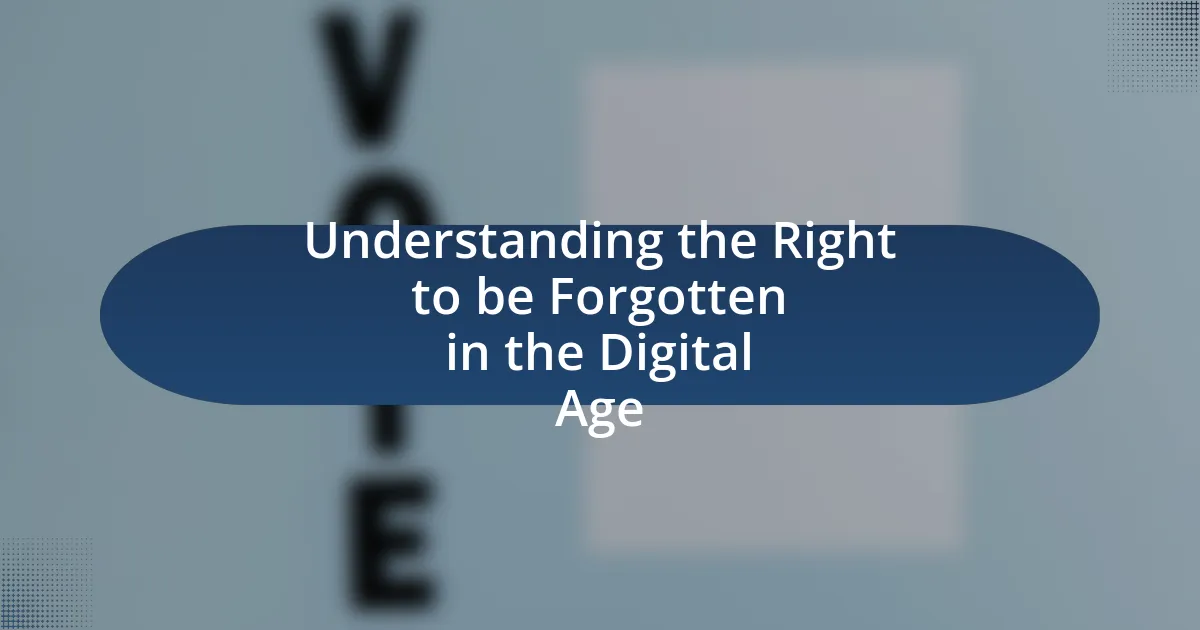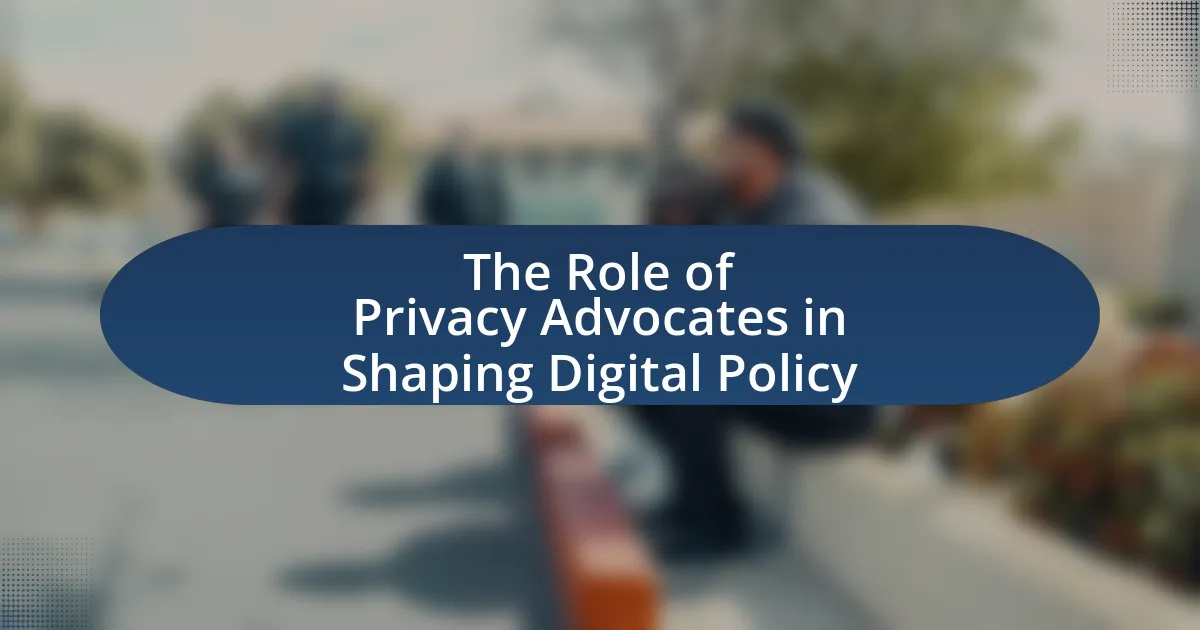Data breaches are incidents where unauthorized access to sensitive information occurs, leading to significant implications for consumer trust and digital rights. This article examines the causes and methods of data breaches, highlighting the role of human error and cybercriminal tactics. It discusses the impact of breaches on consumer privacy, the erosion of trust in organizations, and the legal frameworks designed to protect consumer data. Additionally, the article outlines consumer rights following a breach and offers best practices for safeguarding personal information, emphasizing the importance of transparency and effective communication in restoring trust post-incident.

What are Data Breaches and Their Significance?
Data breaches are incidents where unauthorized individuals gain access to sensitive, protected, or confidential data, often resulting in the exposure of personal information. The significance of data breaches lies in their potential to undermine consumer trust, as they can lead to identity theft, financial loss, and a general erosion of confidence in organizations’ ability to protect personal data. According to a 2021 report by IBM, the average cost of a data breach was $4.24 million, highlighting the financial implications for businesses and the importance of robust data security measures.
How do data breaches occur?
Data breaches occur when unauthorized individuals gain access to sensitive data, often due to vulnerabilities in security systems. Common methods include phishing attacks, where attackers trick individuals into revealing personal information; malware infections that exploit software weaknesses; and inadequate security measures, such as weak passwords or unpatched software. According to the Identity Theft Resource Center, there were over 1,100 data breaches reported in the United States in 2020 alone, exposing millions of records. This highlights the prevalence and impact of data breaches on consumer trust and digital rights.
What are the common methods used by cybercriminals?
Cybercriminals commonly use methods such as phishing, malware distribution, ransomware attacks, and social engineering. Phishing involves tricking individuals into revealing sensitive information through deceptive emails or websites, with the Anti-Phishing Working Group reporting over 200,000 phishing attacks monthly in 2021. Malware distribution includes the use of malicious software to gain unauthorized access to systems, with a report from Cybersecurity Ventures estimating that global cybercrime costs will reach $10.5 trillion annually by 2025. Ransomware attacks encrypt data and demand payment for its release, with the FBI noting that ransomware incidents increased by 300% in 2020. Social engineering exploits human psychology to manipulate individuals into divulging confidential information, as highlighted by a study from the Ponemon Institute, which found that 43% of data breaches involved social engineering tactics.
What role do human errors play in data breaches?
Human errors are a significant factor in data breaches, accounting for approximately 95% of all cybersecurity incidents. These errors often stem from actions such as misconfigured security settings, weak passwords, and unintentional sharing of sensitive information. For instance, a study by IBM found that human error was a leading cause in 23% of data breaches, highlighting the critical need for employee training and awareness programs to mitigate these risks.
Why are data breaches a concern for consumers?
Data breaches are a concern for consumers because they compromise personal information, leading to identity theft and financial loss. When companies fail to protect sensitive data, such as Social Security numbers or credit card details, consumers face increased risks of fraud. According to the Identity Theft Resource Center, there were over 1,100 data breaches reported in 2020, exposing millions of records. This alarming statistic highlights the vulnerability of consumer data and the potential for significant harm, eroding trust in businesses and digital platforms.
What types of personal information are typically compromised?
Personal information that is typically compromised includes names, addresses, Social Security numbers, credit card information, and login credentials. Data breaches often expose this sensitive information, which can lead to identity theft and financial fraud. According to the Identity Theft Resource Center, in 2021, over 1,800 data breaches were reported, affecting millions of individuals and resulting in the exposure of personal data across various sectors. This highlights the significant risk associated with compromised personal information and its impact on consumer trust and digital rights.
How do data breaches affect consumer privacy?
Data breaches significantly compromise consumer privacy by exposing personal information such as names, addresses, Social Security numbers, and financial details. When organizations fail to protect sensitive data, it can lead to identity theft, financial fraud, and unauthorized access to accounts. According to a 2021 report by IBM, the average cost of a data breach is $4.24 million, highlighting the financial implications for both consumers and businesses. Furthermore, a study by the Ponemon Institute found that 60% of consumers would stop doing business with a company after a data breach, indicating a direct impact on consumer trust and willingness to share personal information in the future.

How Do Data Breaches Impact Consumer Trust?
Data breaches significantly undermine consumer trust by exposing sensitive personal information, leading to feelings of vulnerability and betrayal among customers. Research indicates that 75% of consumers lose trust in a company after a data breach, as highlighted in the 2020 IBM Cost of a Data Breach Report, which also states that the average cost of a data breach is $3.86 million. This erosion of trust can result in decreased customer loyalty, reduced sales, and a long-term negative impact on a company’s reputation. Furthermore, a study by the Ponemon Institute found that 60% of consumers would stop doing business with a company that experienced a data breach, illustrating the profound consequences on consumer relationships.
What is the relationship between data breaches and consumer trust?
Data breaches significantly undermine consumer trust. When organizations experience data breaches, sensitive information such as personal identification, financial details, and login credentials are often compromised, leading consumers to feel vulnerable and insecure about their data. According to a 2020 study by IBM, 81% of consumers stated that they would stop doing business with a company that experienced a data breach. This statistic illustrates the direct correlation between data breaches and a decline in consumer confidence, as individuals prioritize their privacy and security. Furthermore, the aftermath of a breach often involves public scrutiny and negative media coverage, which can further erode trust in the affected organization.
How do consumers perceive companies after a data breach?
Consumers generally perceive companies negatively after a data breach, often leading to diminished trust and loyalty. Research indicates that 75% of consumers lose trust in a company following a breach, with many considering switching to competitors. Additionally, a study by the Ponemon Institute found that 60% of consumers would stop doing business with a company that experienced a data breach. This perception is influenced by factors such as the severity of the breach, the company’s response, and the perceived value of consumer data. Thus, the aftermath of a data breach significantly impacts consumer attitudes towards the affected companies.
What factors influence the restoration of trust post-breach?
The restoration of trust post-breach is influenced by several key factors, including transparency, responsiveness, and the implementation of corrective measures. Transparency involves openly communicating the details of the breach, which helps consumers understand the situation and the steps being taken to address it. Responsiveness refers to how quickly and effectively an organization reacts to the breach, including providing support and resources to affected individuals. Implementing corrective measures, such as enhancing security protocols and offering compensation, demonstrates a commitment to preventing future incidents. Research indicates that organizations that prioritize these factors can significantly improve consumer trust levels after a breach, as evidenced by a study published in the Journal of Cybersecurity, which found that 70% of consumers are more likely to trust a company that is transparent about its data practices.
Why do some companies recover trust faster than others?
Some companies recover trust faster than others due to their effective crisis management strategies and transparent communication. Companies that promptly acknowledge the breach, provide clear information about the incident, and outline steps taken to rectify the situation tend to regain consumer confidence more quickly. For instance, a study by the Ponemon Institute found that organizations that communicated transparently about data breaches experienced a 20% faster recovery in consumer trust compared to those that did not. Additionally, companies that invest in robust cybersecurity measures and demonstrate a commitment to protecting consumer data can enhance their reputation and rebuild trust more effectively.
What role does transparency play in rebuilding consumer trust?
Transparency is crucial in rebuilding consumer trust following data breaches. When companies openly communicate about the breach, including its nature, extent, and the measures taken to mitigate its impact, they demonstrate accountability. Research by the Ponemon Institute indicates that 70% of consumers are more likely to trust a company that is transparent about data breaches. This openness fosters a sense of security and reassures consumers that their concerns are being addressed, ultimately leading to restored confidence in the brand.
How do effective communication strategies mitigate trust loss?
Effective communication strategies mitigate trust loss by fostering transparency and clarity during crises, such as data breaches. When organizations promptly inform consumers about breaches, detailing the nature of the incident and the steps taken to address it, they demonstrate accountability. Research indicates that 70% of consumers are more likely to trust a company that communicates openly about security issues, as seen in a study by the Ponemon Institute, which highlights that transparency can significantly reduce the negative impact of data breaches on consumer trust. By maintaining ongoing dialogue and providing regular updates, organizations can reassure consumers, thereby preserving trust even in challenging situations.

What Are the Implications for Digital Rights Following Data Breaches?
Data breaches significantly undermine digital rights by compromising personal privacy and security. When organizations fail to protect sensitive information, individuals face increased risks of identity theft, unauthorized access to personal data, and loss of control over their digital identities. For instance, the 2017 Equifax breach exposed the personal information of approximately 147 million people, highlighting the severe consequences of inadequate data protection. This erosion of trust can lead to a reluctance among consumers to engage with digital services, ultimately impacting their rights to privacy and data protection as outlined in regulations like the General Data Protection Regulation (GDPR). The implications extend to potential legal repercussions for organizations, as they may face fines and lawsuits for failing to uphold their responsibilities in safeguarding consumer data.
How do data breaches affect digital rights legislation?
Data breaches significantly influence digital rights legislation by prompting lawmakers to strengthen data protection laws and enhance consumer privacy rights. For instance, high-profile breaches, such as the Equifax incident in 2017, led to increased scrutiny and the introduction of regulations like the California Consumer Privacy Act (CCPA) in 2018, which aims to give consumers more control over their personal information. Additionally, the European Union’s General Data Protection Regulation (GDPR), enacted in 2018, was partly a response to widespread data breaches, establishing stringent requirements for data handling and imposing heavy fines for non-compliance. These legislative changes reflect a growing recognition of the need to protect individuals’ digital rights in the face of increasing cyber threats.
What are the current laws protecting consumer data?
The current laws protecting consumer data include the General Data Protection Regulation (GDPR) in the European Union, the California Consumer Privacy Act (CCPA) in the United States, and the Health Insurance Portability and Accountability Act (HIPAA) for health information. GDPR mandates strict guidelines for data processing and gives consumers rights over their personal data, including the right to access and delete their information. CCPA enhances privacy rights and consumer protection for residents of California, allowing them to know what personal data is collected and to whom it is sold. HIPAA establishes standards for the protection of health information, ensuring that individuals’ medical records are kept confidential. These laws collectively aim to enhance consumer trust and safeguard digital rights in the face of increasing data breaches.
How do breaches influence the development of new regulations?
Breaches significantly influence the development of new regulations by exposing vulnerabilities in existing frameworks and prompting legislative bodies to address these gaps. For instance, the 2017 Equifax data breach, which compromised the personal information of approximately 147 million people, led to increased scrutiny and the introduction of the California Consumer Privacy Act (CCPA) in 2018. This act aimed to enhance consumer rights regarding personal data and establish stricter compliance requirements for businesses. Such incidents serve as catalysts for regulatory change, as they highlight the need for stronger protections and accountability measures in the digital landscape.
What rights do consumers have in the wake of a data breach?
Consumers have specific rights in the wake of a data breach, including the right to be informed, the right to access their data, and the right to seek compensation. When a data breach occurs, organizations are typically required by laws such as the General Data Protection Regulation (GDPR) and various state laws in the U.S. to notify affected individuals about the breach promptly. This notification must include details about the nature of the breach, the data involved, and steps consumers can take to protect themselves. Additionally, consumers have the right to access their personal data held by the organization and request corrections if inaccuracies are found. Furthermore, consumers may have the right to seek compensation for damages resulting from the breach, depending on the jurisdiction and specific circumstances of the incident. These rights are designed to empower consumers and enhance their control over personal information in the digital landscape.
How can consumers protect their rights after a breach?
Consumers can protect their rights after a breach by promptly reporting the incident to the affected organization and relevant authorities, such as the Federal Trade Commission (FTC) in the United States. Reporting allows consumers to document the breach and seek remedies, including credit monitoring services or identity theft protection, which many companies offer post-breach. Additionally, consumers should review their financial statements and credit reports regularly to identify any unauthorized activity, as the Fair Credit Reporting Act entitles them to one free credit report annually from each of the three major credit bureaus. This proactive approach helps consumers mitigate potential damage and assert their rights effectively.
What recourse do consumers have against companies that fail to protect their data?
Consumers have several recourses against companies that fail to protect their data, including legal action, regulatory complaints, and seeking compensation. Legal action can involve filing lawsuits for negligence or breach of contract, as seen in cases like the Equifax data breach, where consumers were awarded settlements. Regulatory complaints can be lodged with agencies such as the Federal Trade Commission (FTC) in the United States, which enforces data protection laws and can impose fines on companies for violations. Additionally, consumers may seek compensation through class-action lawsuits, which allow groups of affected individuals to collectively pursue claims against a company. These avenues provide mechanisms for accountability and potential restitution for consumers whose data has been compromised.
What best practices can consumers adopt to safeguard their data?
Consumers can safeguard their data by implementing strong, unique passwords for each account and enabling two-factor authentication (2FA) wherever possible. Strong passwords reduce the risk of unauthorized access, while 2FA adds an additional layer of security, making it significantly harder for attackers to compromise accounts. According to a study by Google, 2FA can block 100% of automated bots and 96% of bulk phishing attacks, demonstrating its effectiveness in protecting sensitive information. Additionally, consumers should regularly update their software and devices to patch vulnerabilities, as outdated systems are prime targets for cybercriminals.
How can consumers enhance their online security?
Consumers can enhance their online security by implementing strong, unique passwords for each account and enabling two-factor authentication (2FA) wherever possible. Strong passwords typically consist of at least 12 characters, including a mix of letters, numbers, and symbols, which significantly reduces the risk of unauthorized access. According to a study by the National Institute of Standards and Technology (NIST), using 2FA can block 99.9% of automated attacks, making it a crucial step in protecting personal information. Additionally, regularly updating software and being cautious of phishing attempts further contribute to improved online security.
What steps should consumers take if they suspect a data breach?
If consumers suspect a data breach, they should immediately change their passwords for affected accounts. This action helps secure their information and prevents unauthorized access. Following the password change, consumers should monitor their financial statements and credit reports for any unusual activity, as data breaches can lead to identity theft. Additionally, consumers should report the breach to the affected company and consider placing a fraud alert on their credit files with major credit bureaus. According to the Federal Trade Commission, timely reporting and monitoring can significantly mitigate the risks associated with data breaches.





